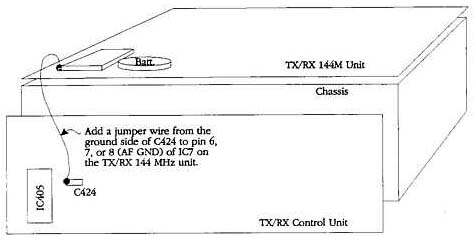Assembly Mode Test
In the TM-733 Service Manual, it describes a test mode that I haven't
seen mentioned anywhere else. So, here's the scoop:
Entering Assembly Mode: [CALL] + [MUTE] + [Power On]
All LCD segments should come on. (To exit, power off.)
Press the [VFO] key. *This must always be done first*
The serial port is checked and "F" with "80" on the display indicates
test passed. "1" or "2" means failure.
Different keys now show different displays, with [LOW], [SHIFT],
[TONE], and [REV] also adjusting the backlight intensity.
Set the dials to minimum, then press the [MR] key. Each of the dials
shows the digitized level.
This looks useful for checking all the keys and dials when you suspect
a bad connection.
Kenwood TM-733A Quick Reference Guide by Brad Killebrew N5LJV
-----------------------------------------------------------------------------
[#] PRESS A NUMBER, NOT THE POUND SIGN.
[KEY] PRESS AND RELEASE [KEY]
[KEY1]+[KEY2] PRESS AND HOLD [KEY1] DOWN, THEN PRESS [KEY2]
[KEY1],[KEY2] PRESS [KEY1] MOMENTARILY, THEN PRESS [KEY2]
[KEY]+[PWR] WITH POWER OFF, PRESS AND HOLD [KEY] THEN HIT [PWR]
[KEY1]+[KEY2]+[PWR] YOU GET THE IDEA.
[F] (1s) PRESS AND HOLD [F] FOR ONE SECOND. "F" THEN BLINKS.
[KEY] (1s) PRESS AND HOLD [KEY] FOR ONE SEOND.
[F],[KEY] (1s) PRESS [F] MOMENTARILY, THEN PRESS [KEY] FOR ONE SEC.
-----------------------------------------------------------------------------
The following entries are in alphabetical order.
1 MHZ/10 MHZ TUNING TOGGLE [VFO],[F]+[MHZ]
ADVNACED INTERCEPT POINT (AIP) [F]+[A.B.C.]
ALL LOCK [F],[MHZ],[PWR],[F]+[PWR]
AM/FM MODE [MHZ] (1s)
AUTO DIMMER CHANGE [F]+[LOW]+[PWR]
AUTOMATIC BAND CHANGE (A.B.C.) [F],[A.B.C.]
AUTOMATIC OFFET (CANCELLING) [VFO]+[REV]+[PWR]
AUTOMATIC POWER OFF (APO) [F] (1s),[MHZ]
AUTOMATIC SIMPLEX CHECKER [REV] (1s)
AUTOMATIC SQUELCH [MHZ] + [PWR]
AUTOMATIC TONE FREQUENCY ID [TONE] (1s)
BAND SCAN [VFO] (1s)
BEEP LOUDNESS [F] (1s),[BEEP]
BLANKING A BAND DISPLAY [F] (1s), [BAND SEL]
CALL CHANNEL CHANGING (ODD SPLIT) (RX FR),[F],[C.IN] (1s),(TX FR)[CALL]
CALL CHANNEL CHANGING (SIMPLEX,DUPLEX) [F],[C.IN]
CALL CHANNEL RECALLING [CALL]
CALL/MEMORY SCAN [MR],[CALL] (1s)
CALL/VFO SCAN [VFO],[CALL] (1s)
CANCELLING AUTOMATIC OFFET [VFO]+[REV]+[PWR]
CHANGING CALL CHANNEL (ODD SPLIT) (RX FR),[F],[C.IN] (1s),(TX FR)[CALL]
CHANGING CALL CHANNEL (SIMPLEX,DUPLEX) [F],[C.IN]
CHANNEL DISPLAY FUNCTION [REV]+[PRW]
CONFIRMING PROGRAMMABLE LIMITS [F]+[VFO],(L.SHOWN),[MR](U.SHOWN)
CTCSS [TONE],TOGLE TILL "CT" APPEARS
CTCSS TONE FREQUENCY (SELECTING) [F] (1s),[T.SEL],[UP]/[DOWN]
DIMMER (AUTO CHANGE) [F]+[LOW]+[PWR]
DIMMER (DISPLAY) [F],[DIM]
DISPLAY DIMMER [F],[DIM]
DISPLAY DOMONSTRATION MODE [CALL]+[PWR]
DTMF CONFIRMATION TONES [PTT]+[DWN]+[PWR]
DTMF IN AUTOMATIC DIALER (STORING) [F]+[CALL]+[PWR],{#'s},[PF],[#]
DTMF NUMBERS (RECALLING STORED) [F]+[CALL]+[PWR],[MR],[#]
DTMF NUMBERS (TRANSMITTING STORED) [PTT]+[PF],[#]
DUAL TONE SQUELCH SYSTEM (DTSS) [F],[DTSS]
DUAL TONE SQUELCH SYSTEM (TONE SELECT) [F] (1s),[C.SEL],[#],[SHIFT],ETC.
ERASING MEMORY CHANNELS [MR],[F]+[MR]
ERASING PROGRAMMABLE MEMORY [F]+[PM],[#],[MR]
FREQUENCY READOUT BY BEEPS [F]+[TONE]+[PWR],[PF]
FREQUENCY STEP SIZE [VFO],[F],[STEP]
FULL RESET (MINUS PM) [MR]+[PWR],[F],[MR]
FULL RESET (PLUS PM) [MR]+[PWR],[MR]
INITIALIZE FULL RESET (MINUS PM) [MR]+[PWR],[F],[MR]
INITIALIZE FULL RESET (PLUS PM) [MR]+[PWR],[MR]
INITIALIZE VFO BOTH BANDS [VFO]+[PWR]
INITIALIZE VFO ONE BAND [VFO]+[BAND SEL]+[PWR]
LOCK (ALL) [F],[MHZ],[PWR],[F]+[PWR]
LOCK (TRANCEIVER) [F],[MHZ]
LOCK (TRANSMIT BAND) [F],[BAND SEL]
LOCKING OUT MEMORY CHANNELS [MR],[F] (1s),[MR]
MEMORY CHANNELS (LOCKING OUT) [MR],[F] (1s),[MR]
MEMORY ERASING CHANNELS [MR],[F]+[MR]
MEMORY RECALLING CALL CHANNEL [CALL]
MEMORY SCAN [MR] (1s)
MEMORY TO VFO TRANSFER [F],[VFO]
MEMORY WRITING (ODD SPLIT) (RX FRQ),[F],[MR] (1s),(TX FRQ)[MR]
MEMORY WRITING (SIMPLEX, DUPLEX) [F],(FREQ),[MR]
MUTE [MUTE]
PACKET BAUD RATE TOGLE [F]+[STEP]
POWER OUTPUT [LOW]
PROGRAMMABLE BAND SCAN [F]+[VFO],(L.FRQ),[MR],(U.FRQ),[MR]
PROGRAMMABLE LIMITS (CONFIRMING) [F]+[VFO],(L.SHOWN),[MR](U.SHOWN)
PROGRAMMABLE MEMORY (ERASING) [F]+[PM],[#],[MR]
PROGRAMMABLE MEMORY (RECALLING) [PM],[#]
PROGRAMMABLE MEMORY (STORING) [F],[PM],[#]
PROGRAMMABLE MEMORY SCAN [PM]+[PWR],[PM] (1s)
RD OUTPUT SQUELCH CONTROL [TONE]+[PWR]
RECALLING MEMORY CALL CHANNEL [CALL]
RECALLING PROGRAMMABLE MEMORY [PM],[#]
RECALLING STORED DTMF NUMBERS [F]+[CALL]+[PWR],[MR],[#]
RECEIVE AUDIO SWITCHING [F] (1s) [CONT SEL]
REMOTE CONTROL MODE [F]+[CONT SEL]
S-METER SQUELCH [F] (1s), [S.QSL]
SCAN (BAND SCAN) [VFO] (1s)
SCAN (CALL/MEMORY) [MR],[CALL] (1s)
SCAN (CALL/VFO) [VFO],[CALL] (1s)
SCAN (PROGRAMMABLE BAND SCAN) [F]+[VFO],(L.FRQ),[MR],(U.FRQ),[MR]
SCAN (PROGRAMMABLE MEMORY) [PM]+[PWR],[PM] (1s)
SCAN MEMORY [MR] (1s)
SCAN RESUME TOGLE (CO, TO) [F] (1s),[VFO]
SELECTING A CTCSS TONE FREQUENCY [F] (1s),[T.SEL],[UP]/[DOWN]
SQUELCH (AUTOMATIC) [MHZ] + [PWR]
SQUELCH (RD OUTPUT CONTROL) [TONE]+[PWR]
SQUELCH (S-METER) [F] (1s), [S.QSL]
SQUELCH HANG TIME [F]+[DIM]
STORING DTMF IN AUTOMATIC DIALER [F]+[CALL]+[PWR],{#'s},[PF],[#]
STORING PROGRAMMABLE MEMORY [F],[PM],[#]
TIME-OUT TIMER [F] (1s),[TOT]
TONE ALERT [F],[T.ALT]
TONE ALERT - CHANGE TONE [F]+[SHIFT]+[PWR]
TRANCEIVER LOCK [F],[MHZ]
TRANSMIT BAND LOCK [F],[BAND SEL]
TRANSMITTING STORED DTMF NUMBERS [PTT]+[PF],[#]
UHF+UHF OPERATION [F],[CONT SEL]
VFO TUNING LIMITS [F]+[C.IN],(L.FRQ)[MR],(U.FRQ)[MR]
VHF+VHF OPERATION [F],[CONT SEL]
WRITING MEMORY (ODD SPLIT) (RX FRQ),[F],[MR] (1s),(TX FRQ)[MR]
WRITING MEMORY (SIMPLEX, DUPLEX) [F],(FREQ),[MR]
If you have additions or corrections to this file, please send it to
Brad Killebrew N5LJV at n5ljv@uh.edu, or packet n5ljv@f6cnb.#setx.tx.usa.na.
Standard Disclaimer: The authors take absolutely no responsibility for
the material presented in this document. The procedures contained herein
work on the author's radios, but proceed at your own risk.
|
